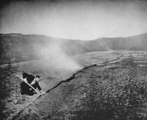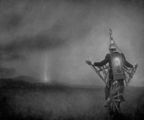 The
images of Robert and Shana ParkeHarrison - at the Figge Art Museum
through October 29 - transport us through narrative image to a
world that is parallel to our own, but oddly vacant and visually
strange, owing largely to things being out of scale, a lack of color,
and metaphorical structures such as gears turning beneath the surface
of the earth.
The
images of Robert and Shana ParkeHarrison - at the Figge Art Museum
through October 29 - transport us through narrative image to a
world that is parallel to our own, but oddly vacant and visually
strange, owing largely to things being out of scale, a lack of color,
and metaphorical structures such as gears turning beneath the surface
of the earth.
Where exactly these worlds exist is unclear, but the place suggests a 19th Century country where an impoverished inventor is trying to build new machines out of scrap parts. Or it may be a future place after an environmental disaster that is populated by a sole survivor who is trying to save what he can while being over-equipped with archaic tools and under-equipped with appropriate technology. The message seems to be that the task before him is enormous, and the odds of success are in question, at best.
This region seems to be inhabited by only one man, who always wears the same slightly-too-small suit. The man, who is actually the artist (and who, metaphorically, is also us), is at times a musician playing a melody on a violin made from scrap parts atop a tree stump, an inventor who builds strange machines for flying, a mythic traveler, a healer who is trying to right injuries done to the earth, and a writer who is wired to felled trees via a telepathic helmet, so as to relate the stories that only the trees can tell.
This archetypal man is often depicted as puny in scale compared to the tasks that he has undertaken, especially in light of the tools he has at his disposal, which seem to have been pieced together from junkyard salvage or improvised from the leftovers after a cataclysm. The fact that Robert ParkeHarrison himself is the main character may suggest what the couple thinks the role of the artist might be in our age: poet, conservationist, inventor, scientist, and, in general, a positive force trying to save, in some small way, a world intent on its own destruction.
In Pollination, the suit-clad man has climbed the stalk of a mature plant and is shouting off and sending forth the seeds with their hairlike structures for airborne transportation to the plant they are about to pollinate. As in many cases, the man is aiding nature in an act akin to kicking the baby birds out of the nest to ensure the continuity of the species.
These works lie between the worlds of sculpture, photography, painting, theatre, and mythology. The artists first generate a story or idea that is recorded as a conceptual sketch; then a set is constructed and photographed; then pieces are collaged together and unified with painting. The pieces are either photogravures (a photo print on an intaglio plate, related to etching) or, more commonly, mixed-media images on panels with a smooth surface that masks the complexity of process that produced them.
They at first appear to be photographs, but clearly are not merely that. The next conclusion to which one inevitably jumps is that the images are digitally produced, and that would explain the compositing and juxtaposition that makes them poetic and interesting. But no Photoshop is involved - only set-building, traditional photography, and analog manipulation, which makes this surprising work even more surprising.
It is as if the techniques the artists have employed have been suggested by the "view camera aesthetic" inherent in their images. The pieces have the unmistakable disquietude that we have seen in Civil War battlefield photos. They are somewhere between black-and-white and sepia-toned, what could best be described as a warmed grayscale. As in all aspects of their work, the artists prefer a bit of mystery to full disclosure as to what is really going on and how it is made.
 Visitors
to the show (titled The
Architect's Brother)
should definitely check out the video presentation on the first floor
of the Figge to see the artists discussing the world they have
created as they build a set and photograph.
Visitors
to the show (titled The
Architect's Brother)
should definitely check out the video presentation on the first floor
of the Figge to see the artists discussing the world they have
created as they build a set and photograph.
Although the show invokes mystery and myth, there is an unmistakable comment upon our relationship to the natural world and our responsibility as stewards of that world. The exhibit is as timely in that respect as it is archaic in its appearance. This unusual juxtaposition makes for an exhibit of wonderfully strange narrative and refined technique that leaves you slightly unsettled but impressed, in the way that provocative works of art often do.
Rather than being too quick to use descriptors such as "creepy" or "dark," look beyond the surface to work that reveals itself to be mythological, environmental, foreboding, and subtly humorous. One should first consider the actions of the suit-wearing man, who is attempting to invent, heal, illuminate, investigate, and explore as artists have generally done in any age.
More of the ParkeHarrisons' work can be seen at (http://www.parkeharrison.com).








